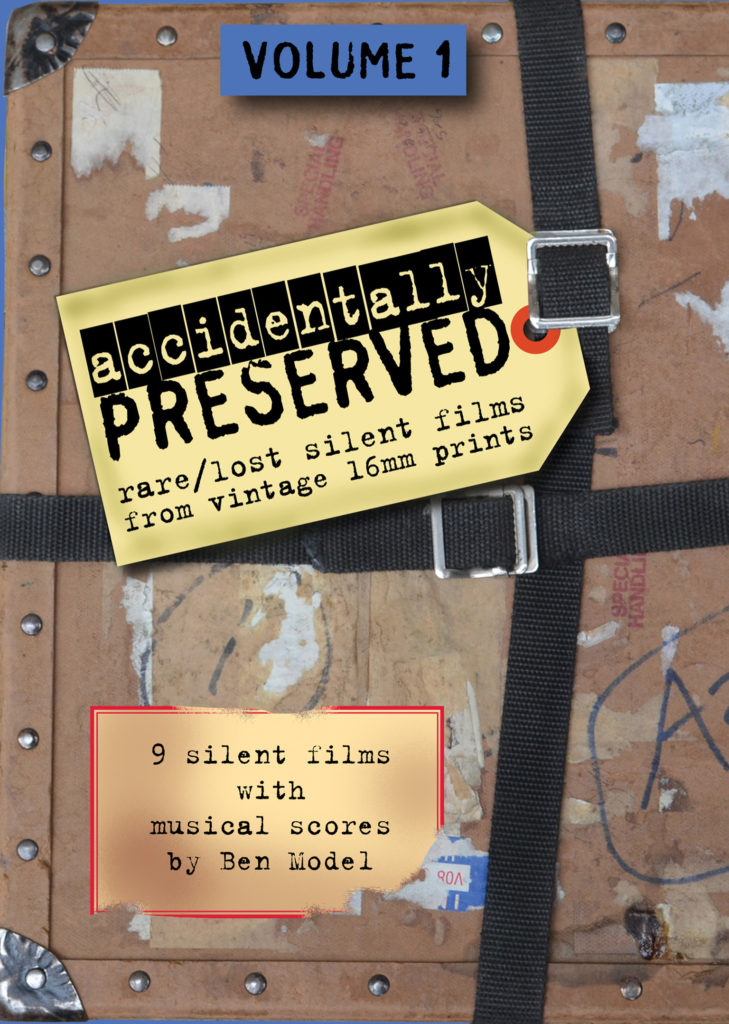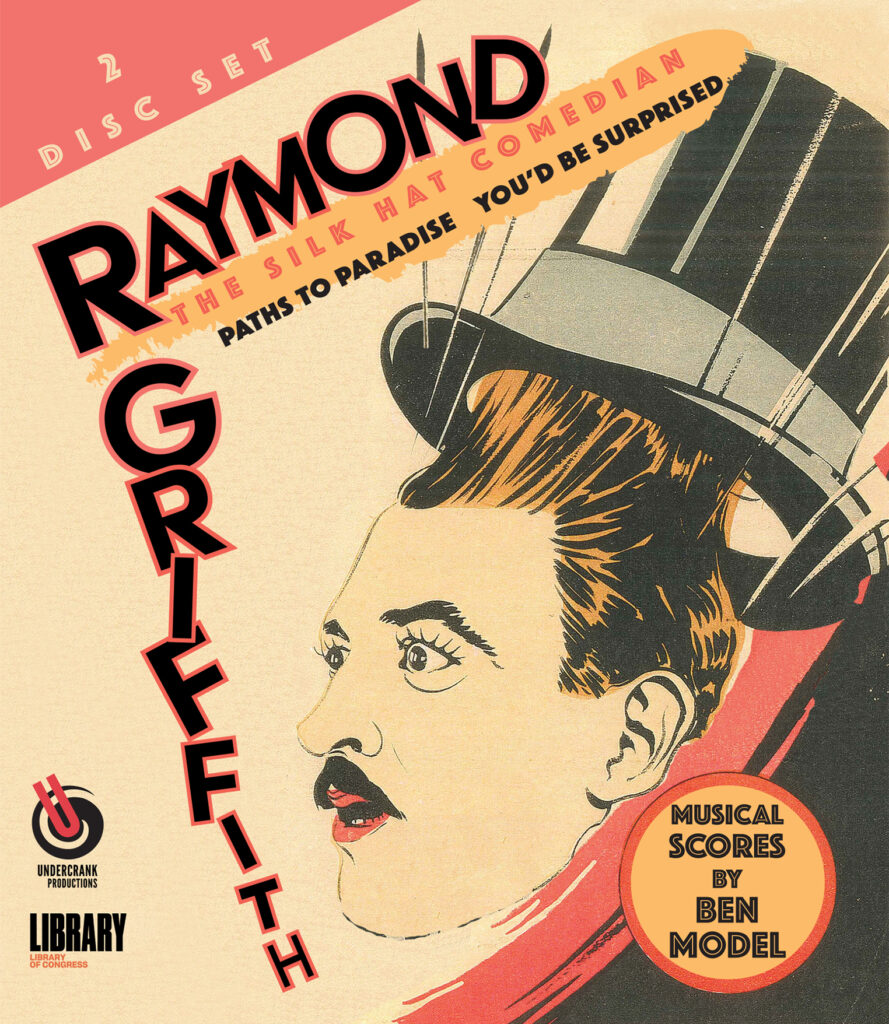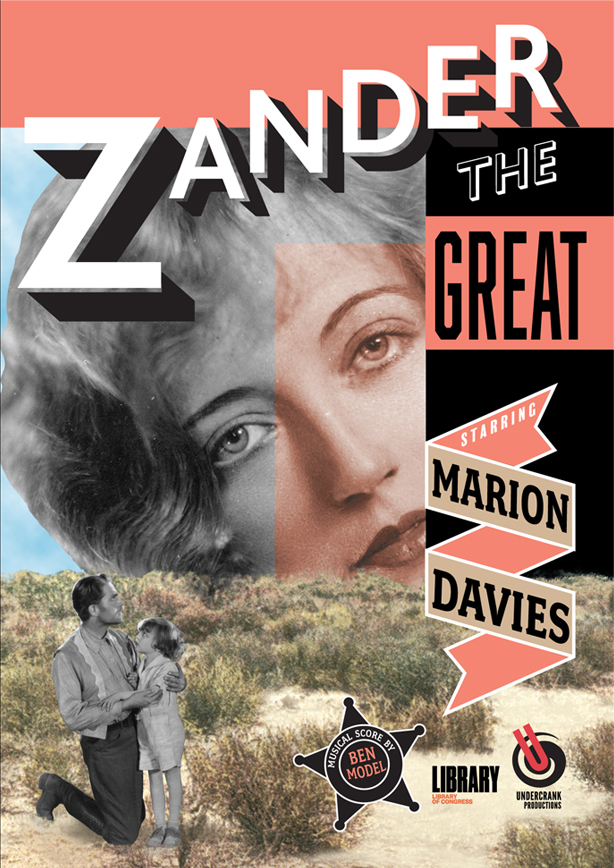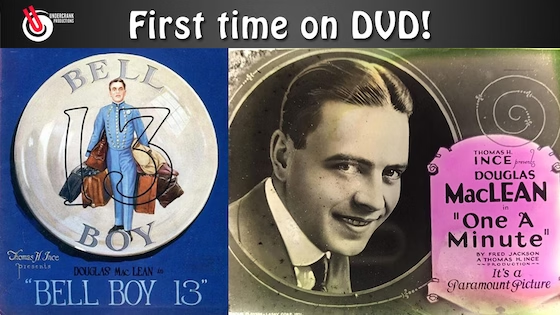Happy summer, everyone! I’m back in the fray, and I’m kicking off the month of June with this Q&A with silent film accompanist, historian, presenter, and home video “artrepreneur” Ben Model. If you’re into silent films–especially if your motto is “The More Obscure, The Better”–then you’re definitely familiar with his quality DVD releases such as Found at Mostly Lost, The Alice Howell Collection, The Mishaps of Musty Suffer, Beverly of Graustark, and many more. (I’ve been happy to review a number of Undercrank releases over the years–you can check out the links here.) And happily, Undercrank turns ten years old this month! Ten years of successful, crowdfunded restored-and-scored rarities–with more to come.
As Undercrank’s own site describes:
Undercrank Productions is a distributor and producer of quality DVD/ Blu-ray releases of rare silent films that deserve an audience. We work with both archives and private collectors to bring the undiscovered classics of silent cinema from film cans to film fans.
So to celebrate this milestone, let’s get the interview started!
Hello Ben, thanks so much for taking the time to answer my questions! To begin, what made you decide to start a home video label? It must’ve seemed like a risky venture at first, especially since you’re working with such obscure films.
Model: I didn’t intend to start a label, originally, but I was looking for a way to participate more in the scoring of silent films for DVD releases. Becoming the home video outfit that hired me seemed like a good way to make that happen. I did make a point, even with the first release–Accidentally Preserved–to create a product that had a similar presentation quality to others I’d seen by companies like Kino and Image and Milestone. I came up with a name for the label, got HD scans made of some rare silent shorts I owned in 16mm, and hired my friend Marlene Weisman, a professional graphic designer, to create the box art. The success I had with the first project led to a second volume of Accidentally Preserved, and then to my second Kickstarter for the Mishaps of Musty Suffer films. What took the risk off the table for these was the workflow I used, having all the costs covered by fan-funding and by having the DVDs made via manufacture-on-demand. I’d also tested the waters in 2012 by posting a few of the rare shorts I had in 16mm on my YouTube channel, and had gotten an enthusiastic response.
With each release, there’d be more enthusiasm and interest for each one, both in the crowd-funding and in the sales numbers. After the Mishaps of Musty Suffer DVD, the fact that the process was working compelled me to look for other silent films that deserved to be available for fans who were interested. It’s gradually snow-balled–once I finished and released one project, at some point I’d come across another film or forgotten star that piqued my interest, and then that became the next Undercrank production. This has been helped greatly by my having a co-branding arrangement with the Library of Congress. Rob Stone, a Curator in the Moving Image Section of the Library of Congress’ National Audio Visual Conservation Center, put this together with me as a way of helping make some of the lesser-known films the Library has preserved available for fans.
I’ve heard that you were the first person to use crowdfunding to get rare silents on home video, is this true? I think sites like Kickstarter were still fairly new back in 2013, too.
Model: Yes, this hadn’t been done before for a classic or silent film project. Kickstarter itself launched in August 2009, and I did my first Kickstarter in November 2012. The whole idea of going to the fans to collectively fund a creative endeavor was, in fact, pretty new. But I’d seen this already at work with people in the music industry, and applied the idea to what I wanted to try. It worked! And it’s continued to do so–my last few Kickstarters hit their funding goals within 4-6 hours of launching.
Crowdfunding has really seemed to make a huge difference as far as making more silent film restorations and rare releases possible. Would you encourage more historians and preservationists to go that route?
Model: Absolutely. It’s up to us fans and any enthusiasts to help fill out the landscape of silent film. It’s not necessarily for everybody, and not everyone is what I refer to as an “artrepreneur”. But it is feasible and it’s a way to bring films to the public that aren’t on the radar or interest of the more established home video labels.
How do you decide which projects you want to crowdfund, especially when it comes to obscure folks like Musty Suffer? You mentioned that the Library of Congress plays an important role.
Model: I mainly look for silent films that really ought to be available, regardless of how well-known they or their stars are today. What we aim to do is present the disc releases to the public as if they were for a well-known star or film title. Marlene Weisman’s artistry and creativity in designing the DVD and Blu-ray covers really helps that.
You compose most of the accompaniment for the films yourself, is that correct?
Model: Yes, and that was the initial idea. But I’m not locked into being the one who scores every release. Andrew E. Simpson and Jon Mirsalis have approached me with projects that were films they were interested in scoring and getting released, and those have turned out really well.
How do you balance your usual work as a live accompanist and presenter with these ongoing releases? Having contributed to several of your projects so far, I’ve always been impressed with how organized you seem to be and how you send out updates on the project’s progress like clockwork.
Model: It’s not easy. Part of what I have in the back of my head while we’re doing the various stages of productions is that I’m thinking of all the people who’ve pledged to the project, and what I would want if I was one of those fans. I’ve learned from a couple marketing podcasts I listen to about the importance of connection and of sharing your story with people who follow or are interested in your work. There is this long middle period of the project where there’s not a lot to report, and so I try to stay in contact anyway. On the Douglas MacLean project, I sent updates every week or two that shared reviews from the trades about each of MacLean’s films. No one knows who he is, and this gave everyone a “Films of Douglas MacLean” reading that helped fill all of that in.
The last 8 months have been particularly challenging, as I’d said “OK, let’s go!” at the beginning of 2022 to 5 projects that had been percolating during 2021. In-person shows had only been trickling back into existence and I had time to spin all these plates. Then around Labor Day last year the in-person work came back at near-2019 levels, gigs I couldn’t turn down. But we’ve gotten the second Chaney set out, Andrew’s Borzage project, and the Raymond Griffith and Tom Mix Blu-rays are done and coming out in June and July.
I can’t emphasize enough how much this has been possible because of Crystal Kui, who has the title of Associate Producer on all the Undercrank releases but is so much more than that. She’s kept all of these releases moving forward and kept both of us organized so everything that needed to get done got done.
A shoutout to you, Crystal! Your work is much appreciated.
You mentioned Marlene Weisman earlier, the artist who designs your DVD covers. I’m a big fan of her work. Does she normally take the reins on the designs, or do you collaborate on how they should look?
Model: Marlene is amazing, and I consider her cover art to be gallery-quality work. She’s a huge silent film fan, and she does an exemplary job of blending the silent era with a contemporary look. Marlene is the one who comes up with the design ideas, but there is some back and forth on them. I’ve actually learned a lot from these collaborations, and sometimes I can come up with a key image or two for the front cover that I know is the kind of thing she’d be looking for.
I’ve always liked the name “Undercrank Productions,” too. For those who maybe aren’t familiar with your work studying silent comedy filmmaking, can you explain the significance behind it?
Model: What we now refer to as undercranking is a technique used for an individual shot or two in a movie where the film is shot at a slower frames-per-second rate than what it’ll be shown at. This is probably used the most for things like car chases, where the driving or stunts are performed at a slightly slower speed and then look faster when projected. This was the way all the shots were done in silent film, in varying degrees, and it was a part of the language everyone knew. This is why silent movies don’t look like film that’s being shown too fast. In the silent era, everyone was in on it, and was moving just a tad slower to compensate for the speed-up. There’s a lot more to it than this, and I’d encourage your readers to seek out the video essay I did for Criterion “A Study In Undercranking”, that’s on their release of Chaplin’s The Kid.
Your label has always been a small scale operation but it’s become very successful, it seems like every time you start a new Kickstarter project it gets funded almost instantly. What are your thoughts on Undercrank’s future? Is this something you’re planning on working on long term?
Model: I don’t know about long-term, but I’m probably going to continue as long as producing these releases to help fans see lesser-known gems is feasible. Who knows where the audience for silent movies will be or how big it will be five or ten years from now? There’s still plenty of films that deserve to get back out there. If we can figure out a way to streamline the production workflow in some way that doesn’t involve cloning me, perhaps even more of this can happen.
By the way, I just got my copy of the Raymond Griffith set, your latest release! Any hints on upcoming Undercrank Projects we can look forward to?
Model: We’re working on a Francis Ford project with Katherine Fuller-Seeley of the University of Texas at Austin, a project she initiated and brought to us. The main feature is The Craving from 1918 which we have now digitally restored, and there’ll be a few shorts as well. Also, largely because of the success of the many releases I’ve done with the Library of Congress, I’m going to be doing a project with the UCLA Film & Television Archive that will be a co-branded production. It’s a little early to mention the title, but it is another “how is it that this isn’t available on disc?” silents. A Kickstarter for this will happen later in 2023.
Sounds like plenty to look forward to, for sure! Thank you so much for your time, Ben.
—
To check out some of Undercrank’s DVDs for yourself, here are some handy links to:
Deep Discount
https://www.deepdiscount.com/deep-undercrank-anniversary-sale/b247463
http://bit.ly/UCP10-dd
Movies Unlimited
https://www.moviesunlimited.com/sought-after-silents-from-undercrank-productions/b247503
http://bit.ly/UCP10-movunltd
Critics’ Choice
https://www.ccvideo.com/sws-undercrank/b247514
http://bit.ly/UCP10-ccvid
And of course, you can always go to the main site: Undercrank Productions. Happy shopping!
—









Thanks, Lea, for a great interview, and thank you, Ben! for all you have done and continue to do. And also thanks to Marlene and Crystal, and everyone who brings these marvelous projects to life. I’m looking forward majorly to those two projects mentioned at the end. 😀
So am I! Thanks for reading, Donnie.
Great to see you back in action!
Lea, it’s in your mind to review the two Raymond Griffith films (and thanks for mentioning them, i just learned that this set was finished thanks to you)? I have heard that his films have nothing to envy the usual silent comedy suspects and stand very well on their own and two fair articles (with your great writing) may give them the promotion they need to both him and the label.
(For what is worth Hands Up! and You’d be surprised and been for some time with absolutely dreadful picture quality in Youtube but i just refused to watch them, i may just be too accustomed to these new super great modern restorations but maybe is not a bad thing. I was surprised at the amount of detail in the teaser).
Great to see you back in action!
Lea, it’s in your mind to review the two Raymond Griffith films (and thanks for mentioning them, i just learned that this set was finished thanks to you)? I have heard that his films have nothing to envy the usual silent comedy suspects and stand very well on their own and two fair articles (with your great writing) may give them the promotion they need to both him and the label.
(For what is worth Hands Up! and You’d be surprised and been for some time with absolutely dreadful picture quality in Youtube but i just refused to watch them, i may just be too accustomed to these new super great modern restorations but maybe is not a bad thing. I was surprised at the amount of detail in the teaser).
Yes, I’ll likely be reviewing the DVD soon, if not next month for a special project. 🙂
Oh yes I’ve seen those fuzzy prints circulating out there. Although–and this is good news!–there’s a couple decent ones on YouTube now that were uploaded in the past few months. I’ve heard that there USED to be a perfect, clear print of it that played in a theater in L.A., but am not sure where it ended up…
Pingback: Undercrank Productions’ 10th Anniversary – Undercrank Productions